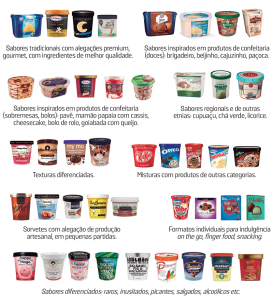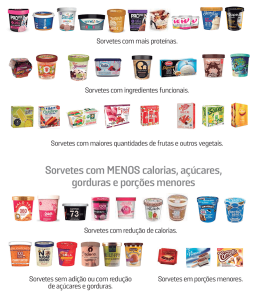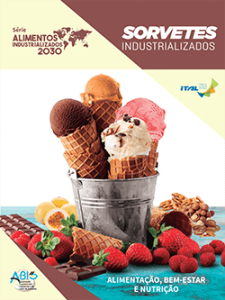CONSUMPTION TRENDS FOR INDUSTRIALIZED ICE CREAMS
The existing records about the origin of ice creams allow us to suppose that its particular sensory attributes have been determined to its incorporation to the dietary habits of many countries, whether as cold sweets or as a greatly appreciated dessert after meals. These attributes are still kept as determining reasons to buy ice cream today, despite ice creams are passing through a moment of transformation regarding the benefits realized by consumers In addition of being consumed as a source of pleasure and well-being, people are in addition valuing its contributions to nutrition, functionality to health, naturalness and sustainability.
The study Brasil Food Trends 2020 serves well as a baseline to understand transformation process in the industrialized ice cream characteristics, from the analysis, in the Brazilian and global market, from different products, at the light of the Sensory and Pleasure and Health and Well-being macrotrends.
SENSORY and PLEASURE
Valuation of gourmet, premium products, variation of flavors, gastronomy, etc.
 The strong sensory appeal is a remarkable characteristic of ice creams and it still prevails in individual choices. For that reason, sensory appeal and pleasure have determined the relationship between manufacturers and consumers, from the very beginning of ice creams marketing. Currently, this macrotrend explains the existence of a wide variety of products with a great diversity of gourmet, premium, exotic, ethnic, confectionery flavors, among others, in addition to the traditional chocolate, strawberry and cream. In addition to taste, there is a growing demand for the combination of intense flavors with attractive and photogenic visuals. People, considered as adventurous in the field of flavor, make the offer of products with adult, nostalgic, rare and unusual flavors to increase.
The strong sensory appeal is a remarkable characteristic of ice creams and it still prevails in individual choices. For that reason, sensory appeal and pleasure have determined the relationship between manufacturers and consumers, from the very beginning of ice creams marketing. Currently, this macrotrend explains the existence of a wide variety of products with a great diversity of gourmet, premium, exotic, ethnic, confectionery flavors, among others, in addition to the traditional chocolate, strawberry and cream. In addition to taste, there is a growing demand for the combination of intense flavors with attractive and photogenic visuals. People, considered as adventurous in the field of flavor, make the offer of products with adult, nostalgic, rare and unusual flavors to increase.
A study conducted by Barry Callebaut found that more than half of North Americans consumers are inclined to choose ice cream that provides new sensory experiences. Among the ten trends highlighted by this company, seven are related to sensory appeal and pleasure: stronger appeal to comfort food with layered ice cream, toppings, fillings and different textures; flavors mixing and combinations of ice cream with confectionery, well-known brands of cookies, etc.; sophisticated flavors from other ethnicities, alcoholic and spiced; spicy and salty flavors; artisanal and small batches ice creams; new formats that allow you to enjoy ice cream in different places and situations; customized flavors according to the flavor preferences of each consumer. And, in addition to the wide variety of flavors, colors, textures, the quality of the experience tends to prevail among consumers.
An study conducted by the company DPO identified the decrease in sales for lower-quality basic products, due to the increase of the preference for ice creams with higher quality ingredients. The concept of quality, from the consumes point of view, has been expanded with the inclusion of new values and personal interests that try to balance comfort food and sustainability.
HEALTH AND WELL-BEING
undefined
Valuation of products for diets, with sugar reduction, fat reduction, plant-based products, etc.
 In the study Brasil Food Trends 2020, the Health and Well-Being macrotrend highlighted characteristics that are currently serving as base for the development of new types of ice cream. Generally, the innovations tend to add value to the products by adding nutritive and functional ingredients and, on the other hand, reduce calories and ingredients that consumers try to avoid, such as, for example, sugar, fat and protein. A research found a global increase of almost 50% in the number of new ice creams with sugar reduction in the period from 2015 to 2019.
In the study Brasil Food Trends 2020, the Health and Well-Being macrotrend highlighted characteristics that are currently serving as base for the development of new types of ice cream. Generally, the innovations tend to add value to the products by adding nutritive and functional ingredients and, on the other hand, reduce calories and ingredients that consumers try to avoid, such as, for example, sugar, fat and protein. A research found a global increase of almost 50% in the number of new ice creams with sugar reduction in the period from 2015 to 2019.
A research conducted by McKinsey, about North Americans milky products consumers identified that more than one-third of respondents have been trying to eat healthier foods. The attributes most associated to food health are “natural” (all natural) and “Low sugar” (low sugar), to 49% of the interviewed consumers, “organic” (38% of the interviewed), “without GMO” (36%), “high protein” (30%), “low fat” (30%), “smaller portions” (26%) and “calories reduction (20%).
Products that substitute lactic-bases ice creams have presented a strong increase in demand, due to the fact they are being positively associated to health. An average annual growth of almost 50% was observed in vegan desserts and ice creams launched over the last five years, and there is a forecast that plant-based ice cream will represent around 30% of the global market by the end of 2027.
The McKinsey research revealed that 62% of consumers bought plant based alternative products in 2018, and that these products are considered healthier that traditional milky products, regarding the fat and protein content. Regarding milky ice creams, 33% of the interviews stated they have reduced the consumption in the last 12 months. Aspect related to sustainability also motivate this demand for substitute plant-based products.
However, from a nutritional point of view, it is necessary to clarify that the trend of reducing dairy consumption is worrying. Milk and by-products naturally contain essential nutrients and are important natural sources of bioavailable calcium. These essential nutrients present in milky products comprise high-quality proteins, potassium, magnesium, vitamin B12, zinc, selenium, folic acid, riboflavin, niacin, iodine and vitamin A. In addition, bioactive properties are related to the milk peptides, with evidence of beneficial effects on the immunologic and digestive system. Also, the exclusive milky fat composition, with favorable profile for fatty acids and with the presence of biologically active lypides, contribute to the single nutritional properties of milk and by-products.




